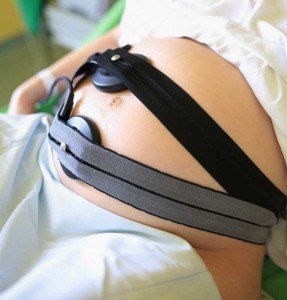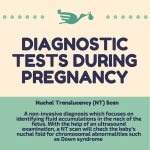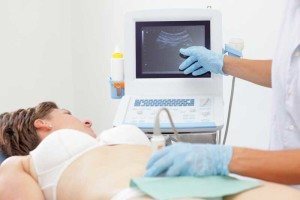
Pregnancy is an exciting time, but it is also accompanied by many fears. The biggest concern that plagues expectant mothers in the months before giving birth is whether their baby is and will be healthy.  To alleviate this fear, prenatal diagnosis can often be helpful. There are a number of test methods today that enable pregnant women to find out before the birth whether their baby has any genetic defects and to take the necessary measures accordingly. In addition to the routine checkups recommended for all expectant mothers, a variety of other prenatal diagnosis methods are available.
To alleviate this fear, prenatal diagnosis can often be helpful. There are a number of test methods today that enable pregnant women to find out before the birth whether their baby has any genetic defects and to take the necessary measures accordingly. In addition to the routine checkups recommended for all expectant mothers, a variety of other prenatal diagnosis methods are available.
First-trimester screening
The screening tests for prenatal diagnosis in the first trimester include a nuchal translucency (NT) scan and a special blood test (triple test). The nuchal translucency scan is a non-invasive method of prenatal diagnosis. With the help of an ultrasound examination, the baby’s nuchal fold is checked for chromosomal abnormalities such as Down syndrome (trisomy 21). Disorders such as autism, heart defects and other chromosomal abnormalities can also be detected using this method. The NT scan focuses on identifying fluid accumulations in the neck of the fetus. Increased fluid accumulation during the first trimester may indicate a genetic defect such as trisomy 21. The diameter of the baby’s nuchal fold is compared to certain standard values, with a nuchal translucency of more than 5mm indicating a high risk of genetic defects. The nuchal translucency scan is usually carried out between 11 and 13 weeks of pregnancy. After the 14th week, the scan can no longer yield accurate results as the fluid accumulation at the back of the baby’s neck begins to decrease. The nuchal translucency scan is usually done together with a special maternal blood test known as the triple test. This test measures the levels of certain hormones (hCG, AFP and estriol) and proteins (PAPP-A) that indicate chromosomal defects. The individual risk can be calculated using several factors, including the age of the mother, week of pregnancy, the width of the nuchal fold, blood test results and an examination of the baby’s nasal bone.
The advantages:

The nuchal translucency scan is relatively easy to perform and carries little risk—most significantly, this method does not pose the risk of suffering a miscarriage.
The disadvantages:
The combined test (nuchal translucency scan and triple test) cannot be used to make a diagnosis but only to calculate the probability of a genetic defect. Whether or not the baby is has a certain disorder cannot be determined with certainty—merely the risk of a genetic disorder can be estimated, which is why further tests are often necessary. This fact can intensify expectant parents’ fears. But abnormal results don’t necessarily mean that the baby has a genetic defect, just as normal results don’t necessarily guarantee that the baby is healthy. Nonetheless, the nuchal translucency scan is a significant prenatal screening tool: In a study of 100,000 women, 75 percent of all cases in which children had Down syndrome could be identified, with the detection rate increasing to 90 percent when a blood test was performed as well. Since the first-trimester screening isn’t considered part of routine prenatal care, the costs of this procedure usually aren’t covered by the mother’s insurance. The exception: If the mother is over 35 years old and there is a reasonable suspicion of genetic abnormalities.
Anatomy scan:
The anatomy scan is also a non-invasive method of prenatal diagnosis. This detailed ultrasound examination is performed between 20 and 24 weeks of pregnancy and serves to detect abnormalities of the baby’s organs such as heart defects. The focus of the scan is on the development of the face, spine, internal organs and limbs. The anatomy scan is not part of routine prenatal care but is a form of targeted prenatal diagnosis that is only covered by the mother’s health insurance if certain risk factors indicate a medical need for the scan. This special screening procedure is carried out using high-resolution ultrasound equipment and must be performed by a qualified physician with the necessary experience.
The advantages:
90 percent of all serious organ malformations, including heart defects, spina bifida and cleft lip and palate, can be identified early by means of the scan. This is especially important in order to detect certain disorders before the baby is born so that the necessary measures can be taken during or after pregnancy. Another advantage of the anatomy scan: If the baby is in a favorable position in utero, great 3-D images can be created for the parents.
The disadvantages:
 Unfortunately, not all malformations can be identified by the ultrasound. Genetic disorders such as Down syndrome, Edwards syndrome and even Patau syndrome cannot be diagnosed.
Unfortunately, not all malformations can be identified by the ultrasound. Genetic disorders such as Down syndrome, Edwards syndrome and even Patau syndrome cannot be diagnosed.
Amniocentesis (amniotic fluid test)
Amniocentesis is an invasive method of prenatal diagnosis. The procedure involves removing amniotic fluid from the amniotic sac and then examining it for indicators of genetic disorders such as Down syndrome (trisomy 21), hereditary diseases and malformations. Amniocentesis is usually carried out between 16 and 18 weeks of pregnancy. During the examination, the amniotic sac is punctured in order to remove cell samples. The abdominal wall is opened by a small incision. Then, the needle is positioned and pushed through the tissue until it reaches the amniotic sac where 15-25 milliliters of amniotic fluid are removed. An ultrasound scan is carried out at the same time to help guide the needle. The mother receives a local anesthetic during the procedure and feels virtually no pain. The results of the amniocentesis are available in approximately two to three weeks, with a rapid test promising results in just one day.
The advantages:
Amniocentesis has an accuracy rate of 99.9 percent, and in contrast to those of the first-trimester screening, the results are unambiguous.
The disadvantages:
Unlike non-invasive screening procedures, amniocentesis carries some risks. These include vaginal bleeding, infection and a temporary loss of amniotic fluid. The risk of suffering a miscarriage, however, is very low: According to reliable studies, it is only about 1 percent and in most cases even lower (0.5 to 1 percent). The risk of injuring the fetus is also minimal if the procedure is performed by an experienced physician. Health insurance only covers the costs of amniocentesis in certain cases, for example, if the mother is over the age of 35 or there is a reason to suspect a chromosomal abnormality. Another drawback: Disorders that are not based on a chromosomal abnormality (metabolic disorders, heart defects or intellectual disability) cannot be detected via amniocentesis.
Chorionic villus sampling (CVS)
Just like amniocentesis, chorionic villus sampling is an invasive method of prenatal diagnosis. This procedure involves the removal of cells from the placenta, also called chorionic villi, which are examined for possible chromosomal abnormalities and genetic disorders. Chorionic villus sampling can only be carried out starting in the 11th week of pregnancy when the embryonic stage of development has concluded. CVS can be done in two different ways: The first method involves inserting a hollow needle through the abdomen to remove a cell sample from the placenta. A second possibility is to remove a cell sample by means of a catheter that is inserted into the placenta through the vagina. To protect the baby during the procedure, CVS is carried out under constant ultrasound monitoring. The removed tissue (about 20-30 milligrams) is then examined in a laboratory for genetic defects such as trisomy 21 and hereditary muscle and metabolic disorders.
The advantages:
CVS can be carried out earlier in the pregnancy than amniocentesis and therefore can offer a diagnosis sooner. First results are available after just one to eight days, with an accuracy of 99 percent. The risks of chorionic villus sampling are comparable to those of amniocentesis, including the possibility of vaginal bleeding and the loss of amniotic fluid after the procedure. Injury to the fetus is possible but highly unlikely if the test is done by an experienced physician.
The disadvantages:
Compared to amniocentesis, CVS carries a slightly higher risk of miscarriage (0.5 to 2 percent). In some cases, the procedure must be repeated because not enough tissue was removed. Another disadvantage compared to amniocentesis: Spina bifida cannot be diagnosed via CVS. The costs are only covered by the mother’s health insurance if the mother is older and there have been previous abnormal findings.
Percutaneous umbilical cord blood sampling (cordocentesis)
 This invasive prenatal diagnosis procedure, which is not often employed, is used to examine the blood of the unborn child. The procedure, during which the doctor inserts a thin needle through the abdomen and into the umbilical cord, only takes a few minutes and doesn’t require local anesthesia. About two milliliters of the baby’s blood are taken from the umbilical vein and subsequently analyzed in a laboratory. Using the baby’s cells that were obtained from the blood sample, a cell culture is started and tested for genetic disorders. This procedure is also useful to test the baby’s blood for anemia and infections or to determine Rh incompatibility between mother and child. Results are available after about two to four days. Percutaneous umbilical cord blood sampling can be done starting in the 17th/18th week of pregnancy. Just as with amniocentesis and chorionic villus sampling, bleeding, infection or loss of amniotic fluid may occur in rare cases.
This invasive prenatal diagnosis procedure, which is not often employed, is used to examine the blood of the unborn child. The procedure, during which the doctor inserts a thin needle through the abdomen and into the umbilical cord, only takes a few minutes and doesn’t require local anesthesia. About two milliliters of the baby’s blood are taken from the umbilical vein and subsequently analyzed in a laboratory. Using the baby’s cells that were obtained from the blood sample, a cell culture is started and tested for genetic disorders. This procedure is also useful to test the baby’s blood for anemia and infections or to determine Rh incompatibility between mother and child. Results are available after about two to four days. Percutaneous umbilical cord blood sampling can be done starting in the 17th/18th week of pregnancy. Just as with amniocentesis and chorionic villus sampling, bleeding, infection or loss of amniotic fluid may occur in rare cases.
The advantages:
Possible infections the child may have developed (toxoplasmosis, fifth disease, cytomegalovirus) can only be clearly identified via umbilical cord blood sampling.
The disadvantages:
The risk of miscarriage from this procedure is between 1 and 3 percent and is therefore relatively high. As with all prenatal diagnosis tests, the costs of cordocentesis are only covered by the mother’s health insurance if the mother is older or there is a reasonable suspicion of abnormalities. Prenatal diagnosis procedures can uncover a number of diseases and genetic disorders and support pregnant women in making the necessary decisions if abnormalities are found. But in many cases, they can also alleviate fears when it turns out that the unborn child is healthy. Together with a competent doctor, every woman should decide for herself whether a prenatal diagnosis is something she would like to consider and which screening or testing method is most appropriate.

